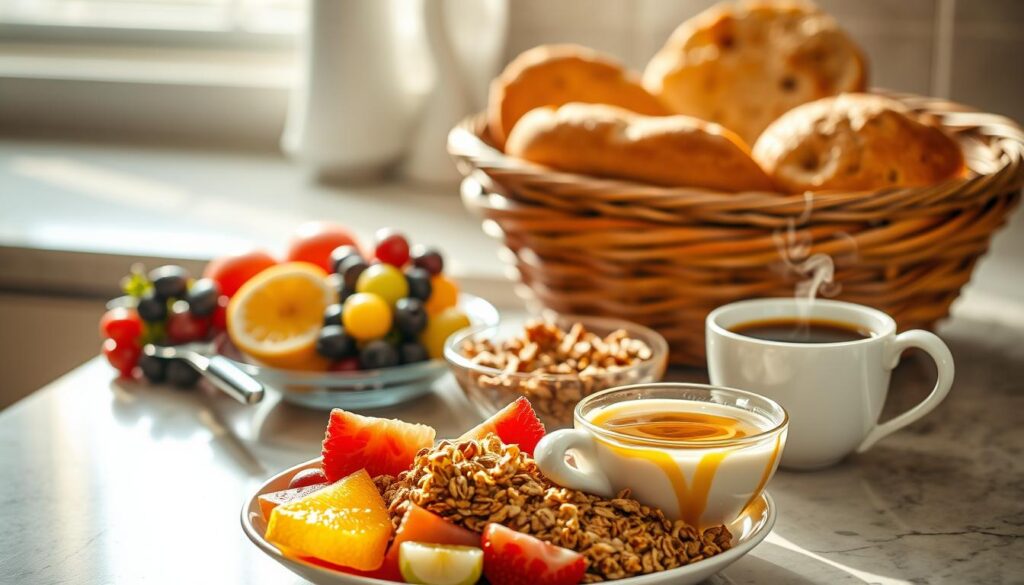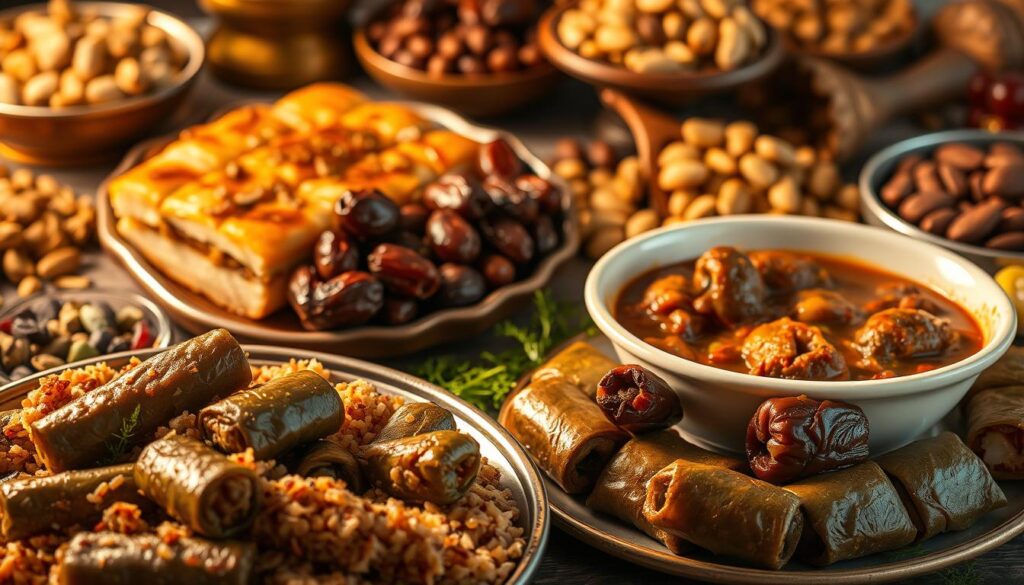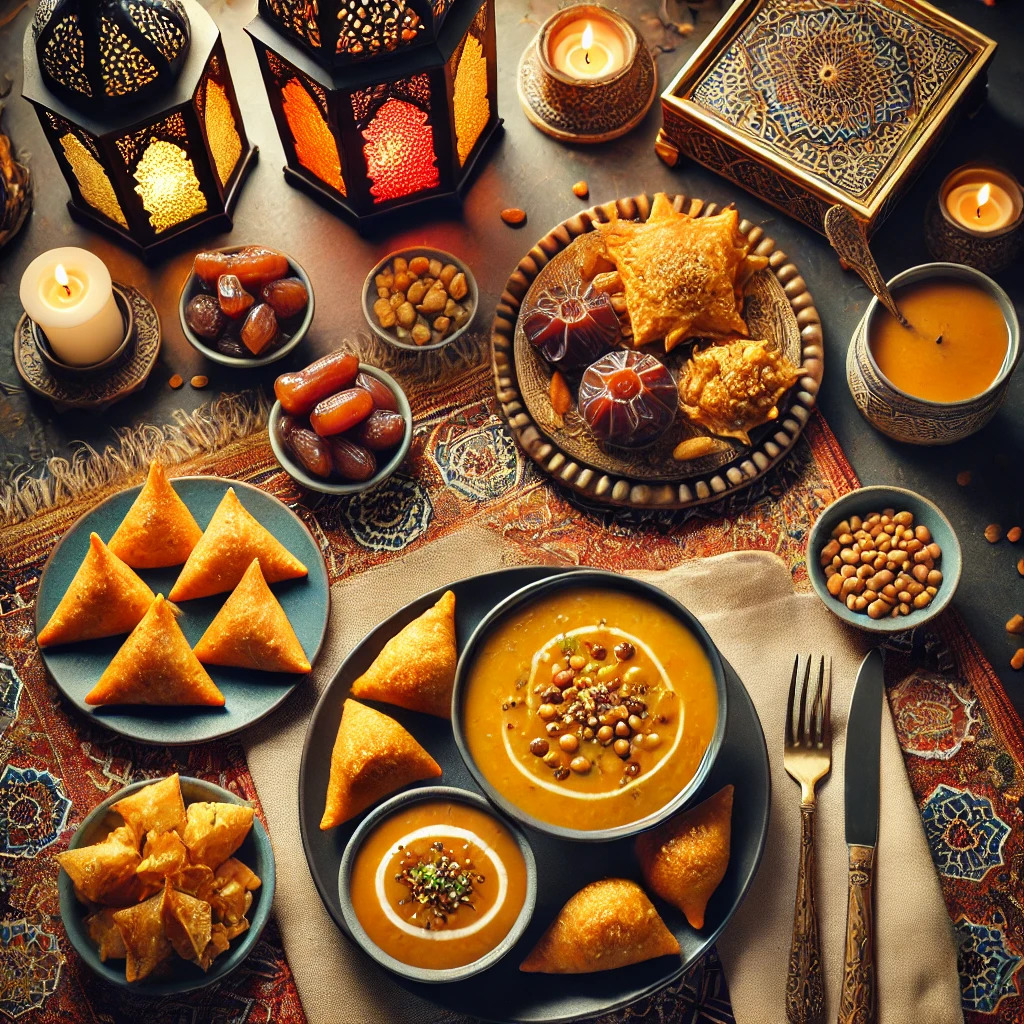Imagine the calm of Suhoor, the quiet before the day’s fast. Every bite is filled with meaning. Iftar is a warm evening, a time to share meals with family, blending tradition and modern convenience.
Whether you’re new to Ramadan or have celebrated it for years, finding the perfect recipes is a yearly quest. You want them to be easy, nutritious, and delicious. The right recipes make Ramadan a flavorful journey.
We’ve gathered over 30 traditional Ramadan recipes from around the world. They offer a mix of flavors and memories. From the first sips of water and dates to the delicious meals that follow, these recipes come from 12 countries like Bahrain and Egypt.
In these pages, you’ll find recipes that fit your busy life. They let you focus on Ramadan’s spiritual and communal sides. These meals fuel your fast and bring joy to your family table. Welcome to a month-long celebration that connects past traditions with today’s simplicity.
Introduction to Ramadan and Its Significance
Ramadan is the ninth month of the Islamic calendar and is very important to Muslims everywhere. This Islamic holy month is a time for fasting, prayer, and thinking deeply. It remembers when the Quran first came to Prophet Muhammad.
The fasting from dawn to sunset is a key part of Islam. It shows how important Ramadan is to Muslims.

Ramadan lasts about 29 to 30 days. It starts on March 1, 2025, and ends on March 30. At first, people fast from 5 a.m. to 5:30 p.m. By the end, it’s from 5 a.m. to 7 p.m.
All adult Muslims must fast, but some are exempt. This includes those who are sick, traveling, menstruating, or have medical issues.
A big part of Ramadan is the Night of Power, Laylat al-Qadr. It’s on the 27th night and marks the first revelation to Muhammad. After Ramadan ends, there’s Eid al-Fitr. It’s a day of prayer, family, and giving thanks.
Tarawih, a night prayer, brings people together. It’s also good to eat Suhoor before dawn and Iftar after sunset. These meals are special and vary by culture, adding to Ramadan’s beauty.
| Aspect of Ramadan | Details |
|---|---|
| Duration | 29 to 30 days |
| Fasting Hours (2025) | 5 a.m. to 5:30 p.m. initially, extending to 5 a.m. to 7 p.m. |
| Observance | Mandatory for adult Muslims, with exceptions |
| Special Nights | Laylat al-Qadr (27th night) |
| End Celebration | Eid al-Fitr |
| Common Meals | Suhoor (pre-dawn), Iftar (post-sunset with dates, milk) |
Muslims around the world have different ways of celebrating Ramadan. The last ten nights are very special. They focus on extra prayers and thinking deeply. This shows Ramadan’s lasting importance in Islam.
Understanding Suhoor and Its Importance
The pre-dawn meal, or suhoor, is key during Ramadan. It helps keep energy and hydration up all day. Choosing the right foods for suhoor is vital for a good fasting experience. Let’s look at what suhoor is, how to make a nutritious Suhoor, and the common ingredients used.

What is Suhoor?
Suhoor is eaten before dawn, about two hours before dawn breaks. In Ramadan 2025, it will be even more important for energy and hydration. It should be eaten just before the final prayer at Fajr, helping you get through the day.
Tips for a Nutritious Suhoor
For a nutritious suhoor, mix different foods for lasting energy and to avoid dehydration. Here’s a helpful guide:
- Slow-release carbohydrates: These give energy slowly. Try oats, whole grains, and sweet potatoes.
- Proteins: Choose eggs, nuts, and yogurt for energy and nutrients.
- Hydrating foods: Fruits and veggies are great for staying hydrated. Think cucumbers, melons, and leafy greens.
- Healthy fats: Nuts and seeds add calories and keep energy up.
Popular Suhoor Ingredients
Using a variety of Suhoor ingredients can make fasting better. Here are some top picks:
| Ingredient | Benefits |
|---|---|
| Dates | They have natural sugars and fibers, fighting hunger and aiding digestion. |
| Bananas | They’re full of potassium and vitamin C, keeping energy and balance. |
| Yogurt | It’s full of probiotics, good for the gut and easy on the stomach. |
| Oats | They give slow energy, lasting all day. |
| Nuts | They offer healthy fats and proteins, a great energy source. |
The variety of suhoor ingredients shows the global nature of Ramadan. Whether it’s traditional foods like yogurt and flatbreads or modern options like smoothies and oats, the goal is the same. Suhoor is a key part of Ramadan.
Quick Suhoor Ideas to Jump-Start Your Day
Ramadan is a month of fasting, lasting 29 to 30 days. It’s important to start your day with quick and nutritious Suhoor ideas. These easy recipes will give you the energy you need.
Date and Banana Smoothie
Start your day with a Date and Banana Smoothie. It’s packed with natural sugars from dates and banana’s fiber. Adding yogurt boosts calories and probiotics. Here’s what you need:
- 4-5 dates, pitted
- 1 banana
- 1 cup of yogurt
- 1/2 cup of milk or almond milk
- 1 teaspoon of honey (optional)
Blend everything until smooth. Enjoy it right away for the best taste.
Besan ki Roti – Gramflour Flatbread
Try Besan ki Roti for a savory choice. It’s made with gram flour and is high in protein. Add fresh veggies for extra nutrition.
- 1 cup gram flour (besan)
- 1/4 cup finely chopped onions
- 1/4 cup chopped coriander
- Spices: cumin, coriander, salt to taste
- Water to knead
Mix the ingredients to make dough. Roll it out and cook until golden brown.

Coconut Date Balls
Coconut Date Balls are a quick and tasty snack. They’re easy to make ahead of time. Each ball is sweet from dates and has healthy fats from coconut.
- 1 cup pitted dates
- 1/2 cup shredded coconut
- 1/4 cup nuts (optional)
- 1 tablespoon honey
Blend the ingredients, shape into balls, and chill for an hour. Each ball is about 200 calories, full of energy and nutrients.
| Recipe | Key Ingredients | Calories | Protein |
|---|---|---|---|
| Date and Banana Smoothie | Dates, Banana, Yogurt, Milk | Approx. 250 | 8g |
| Besan ki Roti | Gram Flour, Onions, Coriander, Spices | Approx. 150 | 7g |
| Coconut Date Balls | Dates, Shredded Coconut, Nuts, Honey | Approx. 200 | 3g |
These recipes are quick and nutritious. They help you start your day right. Feel free to make them your own!
Healthy Iftar Recipes: Balancing Nutrition and Flavor
It’s important to eat well during Iftar to refill your energy without upsetting your stomach. Choosing healthy Iftar recipes can make you feel better during Ramadan. You can enjoy tasty meals that are also good for you by trying different healthy options.

Benefits of a Balanced Iftar
Eating a balanced Iftar has many benefits. It helps keep your energy steady and improves your health. By choosing lighter, healthier foods, you avoid big changes in your blood sugar. This can also help you keep a healthy weight and make fasting easier.
Ingredients to Include
To make nutritious meals, add complex carbs like brown rice and whole grains. They give you lasting energy. Lean proteins like grilled chicken and fish are great, along with lots of fiber from veggies. Fruits like watermelon, pineapple, apples, and oranges are good for their natural sugars and fiber. Air-frying your food can make it even healthier.
| Healthy Ingredients | Benefits |
|---|---|
| Brown Rice | Provides sustained energy |
| Grilled Chicken | Lean protein source |
| Watermelon | Low in calories, high in fiber |
| Air-Fried Foods | Reduces fat and calorie content |
Ingredients to Avoid
It’s key to avoid unhealthy foods during Ramadan. Stay away from processed and sugary foods. They can make your blood sugar go up and down, leading to energy crashes. Fried foods can also harm your heart. Choose foods that are full of nutrients for your Iftar meals.
Traditional Ramadan Dishes from Around the World
Ramadan is a time of spiritual reflection, community, and delicious food. With about 2 billion Muslims worldwide celebrating, the variety of dishes shows the diversity of Ramadan cuisine. Each meal is a reflection of the region’s traditions.

Breaking the fast often starts with dates. There are over 200 types, but medjool dates are the most loved. In Turkey, people flock to bakeries for Ramazan pidesi, a soft bread.
The Middle East loves knafeh, a cheese dessert in sweet syrup. Its origins are debated by Palestine, Egypt, and Syria.
In the Maghreb, Chorba frik, a stew from ancient grains, is a favorite. North Africa enjoys Qatayef, a stuffed pancake dessert. These dishes show the spirit of Ramadan, with unique flavors for everyone.
Morocco’s Harira soup is full of chickpeas and lentils. Indonesia’s Kuih lapis is a layered steamed cake. Uzbekistan’s patır bread and Nigeria’s Jollof rice add to the global cuisine.
Lebanon’s Bamia stew and Malaysia’s Ayam masak merah chicken dish are also favorites. In the U.S., the Black Muslim community has Bean pie, a dessert from the 1930s.
Here’s a table comparing some beloved Ramadan dishes:
| Region | Dish | Main Ingredients |
|---|---|---|
| Turkey | Ramazan pidesi | Leavened Dough |
| Middle East | Knafeh | Cheese, Sweet Syrup |
| Pakistan | Haleem | Meat, Barley, Lentils |
| Morocco | Harira | Chickpeas, Lentils, Tomatoes |
| Indonesia | Kuih lapis | Rice Flour, Colorants |
| U.S. | Bean pie | Navy Beans, Spices |
These dishes are a big part of Ramadan. They show the rich flavors and traditions of Iftar meals. Each meal is a celebration of heritage and unity.
Ramadan Recipes: A Mixture of Tradition and Innovation
Ramadan is a time when food takes center stage, mixing old traditions with new flavors. Breaking the fast with dates and water is a long-standing tradition. Ajwa dates, considered sacred by Muslims, symbolize spirituality and nourishment.
Dates :
These dates are believed to have been planted by the Prophet Muhammad. They are often used to start the Iftar meal, providing a sweet and satisfying beginning.
Modern cooks are now combining these traditional elements with advanced cooking techniques. For example, lamb kofta tacos mix Middle Eastern and Mexican flavors. Another example is the rosewater and pistachio cheesecake, a modern take on traditional Middle Eastern desserts.
Transforming classic drinks into new formats, like mango lassi popsicles, also fits this trend. Shakshuka, a dish loved worldwide, has been updated with harissa paste, showing how traditional recipes can appeal to a global audience.
Reunion:
Families come together for Iftar, creating a sense of community and connection. Sharing meals boosts feelings of harmony and compassion. The use of organic ingredients, like those from Caveman Organics, shows a growing focus on sustainability and health during Ramadan.
Ajwa dates are used in many *modern Ramadan recipes*. They can be found in desserts, savory dishes, smoothies, and grain salads. This versatility allows for a mix of traditional and innovative cooking, appealing to different tastes.
The *traditional Iftar ideas* are also key, with dishes like lentil soup, chicken shawarma, and falafel being favorites. These dishes highlight the importance of cultural and culinary practices. Using vegetables in dishes like grilled eggplant with yogurt and pomegranate shows a move towards healthier eating.
The trend of deconstructed meals, like lighter versions of deep-fried items like samosas, also caters to health-conscious eaters.
| Traditional Dish | Modern Twist |
|---|---|
| Falafel | Falafel Waffles with Spicy Yogurt Sauce |
| Chicken Shawarma | Shawarma Tacos with Pickled Onions |
| Lamb Kofta | Lamb Kofta Tacos with Mint Salsa |
| Mango Lassi | Mango Lassi Popsicles |
By embracing both *traditional Iftar ideas* and *modern Ramadan recipes*, you can enjoy a blend of heritage and innovation. This mix honors Ramadan’s spirit while meeting today’s tastes. It opens up endless possibilities for delicious and meaningful meals.
Vegetarian Ramadan Meals for Suhoor and Iftar
Vegetarians observing Ramadan can enjoy nutritious meals for Suhoor and Iftar. These meals not only keep you energized but also add a burst of flavors. Here are some easy veggie recipes to spice up your Ramadan menu.
Mujadara – Lentils and Rice
Mujadara is a mix of lentils and rice, loved in many Middle Eastern homes. It’s packed with protein and iron, making it great for Suhoor or Iftar. Onions sautéed with spices add flavor, making it simple to make.
Fattoush Salad
Fattoush is a fresh salad perfect for your Ramadan meals. It has cucumbers, tomatoes, and radishes, topped with toasted pita and a tangy dressing. It’s nutritious and tasty, giving you important vitamins and minerals.
Stuffed Dates
Stuffed dates are a favorite for Iftar. They’re filled with nuts or cream cheese. So sweet, give a quick energy boost, and are full of fiber and nutrients.Very easy to make and add a special touch to Iftar.
| Recipe | Key Ingredients | Benefits | Preparation Time |
|---|---|---|---|
| Mujadara | Lentils, Rice, Onions | High in Protein and Iron | 45 mins |
| Fattoush Salad | Cucumbers, Tomatoes, Radishes, Pita Bread | Rich in Vitamins and Minerals | 20 mins |
| Stuffed Dates | Dates, Nuts, Cream Cheese | Quick Energy Boost | 10 mins |
Adding these vegetarian meals to your Ramadan routine keeps you energized and nourished. These recipes show that healthy vegetarian dishes are easy to make and delicious to eat.

Meat and Poultry Recipes for Iftar
As Ramadan starts, Muslims around the world make delicious meals for Iftar. They focus on tasty and healthy dishes to refill energy. There are many *Ramadan meat recipes* to choose from, pleasing every taste.
Chicken Biryani
Chicken Biryani is a favorite in many homes during Ramadan. It’s a mix of spiced rice and chicken, cooked to perfection. This dish is not just tasty but also full of nutrients, making it a hit among *poultry Iftar recipes*.
Adana Kebap
Adana Kebap is a must-try for those who love Turkish food. It’s made from ground meat seasoned with spices, then grilled. This dish is not just delicious but also filling after fasting.
Beef Koobideh
Beef Koobideh is a key Persian dish, known for its juicy beef skewers. It’s mildly spiced, making it great with many sides. For those looking to try new *Ramadan meat recipes*, Beef Koobideh is a great choice. You can find more ideas and recipes here to make your Iftar special.
Embrace the culinary traditions and enjoy the timeless recipes that unite us. Whether you pick Chicken Biryani, Adana Kebap, or Beef Koobideh, these dishes will make your Iftar unforgettable.
Quick and Simple Appetizers for Iftar
As you get ready for Iftar, think about starting with light dishes that are easy to make and very tasty. Appetizers like Sambousek and Crispy Fish Pakora are great for kicking off a delicious meal. They impress everyone, whether it’s family or guests, without taking too much time.
Crispy Fish Pakora
Want a tasty snack? Try Crispy Fish Pakora. It’s ready in under an hour. The dish has fish pieces in a seasoned batter, fried until they’re golden. Enjoy it with a tangy yogurt dip for extra flavor.
Sambousek
Craving Middle Eastern flavors? Sambousek is perfect. It’s made with flaky pastry and savory fillings like meat or cheese. You can use pre-made puff pastry to make it in under an hour. Serve it with a fresh salad for a light and satisfying dish.
For more tasty Iftar ideas, check out a variety of appetizers and main dishes here. You can choose from cheese borek, cheesy mutabbaq with beef, or stuffed baked potatoes with turkey. There are endless options that let everyone help in the kitchen.
Popular Ramadan Sweets and Desserts
Ramadan is a time for reflection, prayer, and community. It’s also a time for celebration with *Ramadan sweets*. From Turkish pastries to South Asian puddings, *traditional Ramadan desserts* are special. They are often the highlight of *popular iftar sweets*.
Künefe – Turkish Cheese Pastry
Künefe is a favorite Turkish cheese pastry for iftar. It’s made with layers of dough, sweet cheese, and sugar syrup. The crispy outside and gooey inside are a delightful surprise.
With over 2112 shares on social media, its popularity is clear.
Samsa – Uzbek Pastry
Samsa is another *traditional Ramadan dessert*. It’s an Uzbek pastry filled with nuts and spices. Baked until golden, it’s a perfect iftar treat.
The flaky pastry and sweet filling are a great combination. For more Ramadan recipes, check out this link.
Meethi Seviyan – Vermicelli Pudding
Meethi Seviyan is a delicious way to end your iftar. This South Asian vermicelli pudding is flavored with cardamom and saffron. It’s a quick 15-minute dish that celebrates festivity.
For more easy, affordable dishes for Ramadan, see this recipe guide.
Whether you love künefe, Samsa, or Meethi Seviyan, these *Ramadan sweets* bring joy to iftar gatherings. They celebrate the essence of *traditional Ramadan desserts*.
Cooling Beverages to Serve During Iftar
Hydration is key during Iftar, more so in warm weather. Drinks like Green Tamarind Chutney, Refreshing Mint Lemonade, and Rosewater Sharbat are great. They refresh and offer health perks.
Green Tamarind Chutney
Green Tamarind Chutney is a tangy standout among Ramadan beverages. Its acidity rehydrates and refreshes you. It’s ideal for hot days to cool down fast.
Refreshing Mint Lemonade
Refreshing Mint Lemonade is a top refreshing Iftar drink. It mixes lemon zest with mint coolness, boosting vitamin C. It’s great for fighting fasting dehydration. For more healthy Ramadan drinks, check out these detox breakfast options.
Rosewater Sharbat
Rosewater Sharbat is a fragrant drink that calms your Iftar. It’s made with rosewater and herbs, soothing and aromatic. It’s a lovely way to enjoy Ramadan traditions while staying cool and hydrated.
Adding these refreshing Iftar drinks to your Ramadan meals honors tradition and boosts health and hydration.
Make-Ahead and Freezer-Friendly Suhoor Ideas
Preparing for Suhoor can be easy with make-ahead and freezer-friendly recipes. In places like Canada, where days are long, having meals ready is key. Freezer-friendly Ramadan recipes make meals delicious and convenient, letting you focus on what’s important.
Chicken Puff Pastries
Chicken Puff Pastries are great for Suhoor. Bake them ahead and freeze for later. Just warm them up in the oven before Suhoor. The savory filling and flaky crust make it a great start to the day.
For more freezer-friendly Ramadan recipes, try different chicken and vegetable mixes. They suit your taste.
Achari Baingan – Eggplant in Pickling Spices
Achari Baingan, with eggplant in pickling spices, adds flavor to Suhoor. It freezes well and tastes great when reheated. Making such dishes ahead adds variety to your mornings.
By using these freezer-friendly recipes, you save time. You also keep the quality of your meals high.
Pakistani Gola Kabab
Pakistani Gola Kabab is a protein-rich choice. These spiced meatballs can be prepped and frozen. Then, they’re quickly reheated for a nutritious Suhoor.
These high-protein dishes keep you full during fasting. They’re perfect for families, big or small. Having meals ready reduces meal prep stress.
Using make-ahead and freezer-friendly recipes helps plan meals better. It reduces stress and ensures nutritious Suhoor options. For more tips, visit this resource on freezer-friendly Ramadan recipes.

